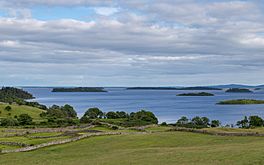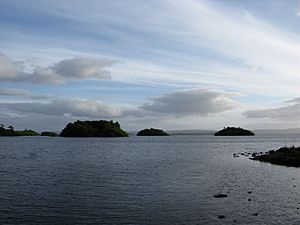Lough Corrib facts for kids
Quick facts for kids Lough Corrib |
|
|---|---|

View on Lough Corrib, south of Clonbur
|
|
 |
|
| Location | Connacht |
| Coordinates | 53°26′N 9°14′W / 53.433°N 9.233°W |
| Native name | Loch Coirib Error {{native name checker}}: parameter value is malformed (help) |
| Primary inflows | Cregg River, River Clare, Black River |
| Primary outflows | River Corrib |
| Basin countries | Ireland |
| Max. length | 43.5 km (27.0 mi) |
| Max. width | 16.1 km (10.0 mi) |
| Surface area | 176 km2 (68 sq mi) |
| Average depth | 6.5 m (21 ft) |
| Max. depth | 50.9 m (167 ft) |
| Designated: | 7 June 1996 |
| Reference #: | 846 |
Lough Corrib (pronounced lokh KORR-ib) is a large lake located in the west of Ireland. It is connected to the sea at Galway by the River Corrib. This makes it the biggest lake in the Republic of Ireland. It is also the second largest lake on the entire island of Ireland, after Lough Neagh.
Lough Corrib covers a huge area of 176 square kilometers (about 68 square miles). Most of the lake is in County Galway, but a small part of its northern end reaches into County Mayo.
The very first canal in Ireland was built here in the 12th century. It was called the Friar's Cut. This canal helped boats travel from Lough Corrib all the way to the sea at Galway.
Lough Corrib is a very special place for nature. It was named a Ramsar site in 1996. This means it's an important wetland for birds and other wildlife. It is also a Special Area of Conservation, which helps protect its unique habitats.
Contents
What's in a Name?
The name Loch Coirib comes from an older name, Loch Oirbsean. This name is linked to a mythical figure called Oirbsen or Oirbsiu. People believed he was a god of the sea, part of the ancient Tuatha Dé Danann group. In Irish, the lake is sometimes simply called An Choirib, meaning "the Corrib".
Discoveries Under the Water
Since 2007, people have been making detailed maps of Lough Corrib. These maps have helped discover many old and important objects hidden underwater. Experts from the National Monuments Service have looked into these finds.
Some of the amazing discoveries include:
- Ancient boats from the Bronze Age and Iron Age. These are Dugout canoes, carved from single tree trunks.
- The "Annaghkeen Boat," which is 40 feet long and has beautiful carvings.
- The "Carrowmoreknock Boat," a well-preserved boat from the 10th century. It was found with three Viking battle axes!
- The remains of a Victorian pleasure yacht.
Because of these finds, Lough Corrib is known as an important place for underwater archaeology around the world. All old shipwrecks and objects in the lake are protected. You need a special permit to dive and explore them.
Amazing Wildlife
Lough Corrib is home to many different kinds of wildlife. You can find various birds and hawks flying overhead. On the ground, there are otters, mink, stoats, frogs, and bats.
The lake itself has two main parts. The southern part is smaller and not as deep. The northern part is larger and much deeper. A narrow channel connects these two sections.
In the southern and eastern areas, the lake bed is mostly limestone rock. This rock is covered by a soft, white material called marl. The land around the lake is mostly farms to the south and east. To the west and north, you'll find more boggy areas.
Besides the lake, some nearby areas are also protected. These include woodlands, special grasslands called callows, and raised bogs. They are all part of the Special Area of Conservation.
Protecting the Lake's Health
Like many natural places, Lough Corrib faces some challenges. One issue is tiny parasites called Cryptosporidium. In 2007, these parasites were found in the lake's water. This caused problems for the public water supply in Galway city and nearby towns. People had to boil their water before drinking it to stay safe.
Another problem is an invasive plant called Lagarosiphon major, also known as 'curly-leaved waterweed'. This plant is not native to Ireland and can harm the fish habitats. The zebra mussel is another invasive species that can cause problems for the lake's ecosystem.
Water Quality Efforts
When Cryptosporidium was found in the water, it was a big concern. It was believed that animal and human waste might have gotten into the lake water. To fix this, money was set aside to improve Galway's water system.
New plans included upgrading the water treatment and filtration systems. They also looked into bringing water from a plant in Luimnagh, which has special equipment to remove Cryptosporidium. These efforts help make sure the drinking water from Lough Corrib is safe for everyone.
Islands of Lough Corrib
People often say Lough Corrib has 365 islands, one for every day of the year! However, a recent survey found there are actually 1,327 islands. That's a lot of islands!
One of the most famous islands is Inchagoil Island. It's located about halfway between Cong and Oughterard. Inchagoil is one of the largest wooded islands on the lake. From here, you can see beautiful views of the Maumturk mountains and Connemara.
Inchagoil Island has lovely beaches and woods with walking paths. It also has signs of an old monastery. You can see two churches there: Saint Patrick's Church and a 12th-century church called the "saints" church. It's said that Saint Brendan of Clonfert, a famous Irish saint, spent time on an island in this lake after his travels. The island also has an old cemetery and the remains of old cottages where people used to live.
Another interesting island is Caislean-na-Circe. This island is special because it's mostly just a rock. On this rock stands the ancient Hen's Castle. This castle belonged to the O'Connor and O'Flaherty families. It was also home to the famous pirate queen Gráinne O'Malley, who lived during the time of Queen Elizabeth I.
You can take boat trips on Lough Corrib to explore these islands and enjoy the scenery. Cruises leave from places like Cong, Ashford Castle, Galway City, and Oughterard.
Lough Corrib in Books
Lough Corrib has inspired many writers. William Wilde, who was the father of the famous writer Oscar Wilde, wrote a book about the lake. It was called Lough Corrib, its Shores and Islands (1867). He even built a summerhouse called Moytura House right on the lake's edge.
The beautiful countryside around Lough Corrib also inspired the children's novel The Hounds of the Morrigan by Pat O'Shea. This shows how special and magical the lake can be!
Images for kids
See also
 In Spanish: Lago Corrib para niños
In Spanish: Lago Corrib para niños




